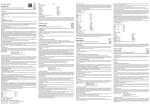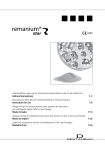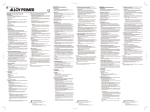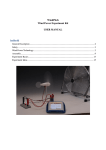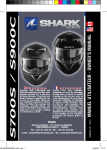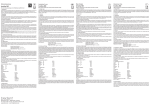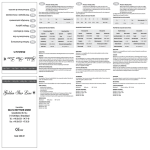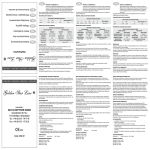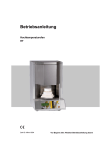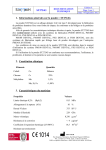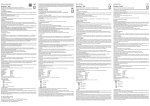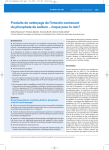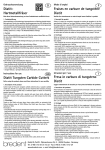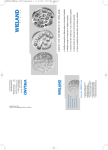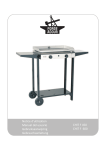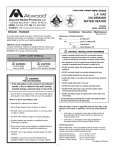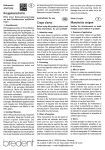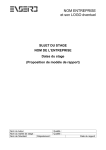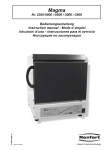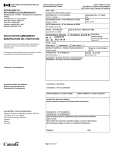Download KERAMIT NP - Nobil
Transcript
KERAMIT NP Lega dentale Co - Cr per metallo ceramica - Tipo 4 Co - Cr based dental alloy for metal-ceramic - Type 4 Co - Basis Aufbrennlegierung - Typ 4 Alliage Co - Cr pour céramo-métallique - Type 4 Aleación Co - Cr para metalocerámica - Tipo 4 Co Cr W Mo Si Nb 63% 24% 8% 3% 1% 1% ISO 22674 - ISO 9693-1 Caratteristiche tecniche • Technical data • Technisce daten Caractéristiques techniques • Caraterísticas técnicas Densità - Density - Dichte - Densité - Densidad g/cm3 8,3 Intervallo di fusione - Melting range - Schmelzintervall Intervalle de fusion - Intervalo de fusión °C 1305 - 1370 Temperatura di colata - Casting temperature - Gießtemperatur Température de coulée - Temperatura de colado °C 1470 10-6K-1 13,9 - 14,0 MPa 490 % 10 GPa 210 HV10/30 285 CET - CTE - WAK - CET - CET 25-500 °C - 25-600 °C Limite elastico 0,2% - Yield strength 0,2% - 0,2% Dehngrenze Limite élastique 0,2% - Limite elástico 0,2% Allungamento - Elongation - Bruchdehnung Allongement - Alargamiento Modulo elastico - Modulus of elasticity Elastizitätsmodul - Module d’élasticité - Módulo de elasticidad Durezza Vickers - Vickers hardness - Vickershärte Dureté Vickers - Dureza Vickers IT KERAMIT NP non contiene Nichel e Berillio, è una lega dentale biocompatibile non preziosa idonea per la tecnica metallo ceramica ed è conforme agli standard delle norme ISO 22674 e ISO 9693-1. ISTRUZIONI PER L’USO Pernatura: mantenere uno spessore del modellato non inferiore a 0,40 mm. Utlizzare perni di colata di almeno Ø2,5 mm per le corone e Ø3,0 mm per i ponti. Per ricostruzioni protesiche superiori ai tre elementi, utilizzare una barra di distribuzione di Ø4,0-4,5 mm. Rivestimento: utilizzare PVF od altro rivestimento a base fosfatica. Preriscaldare il cilindro ad una temperatura di 850/900°C per almeno 30 minuti. Seguire le indicazioni del fabbricante. Fusione: utilizzare un crogiolo ceramico individuale; pulire il crogiolo dopo ogni fusione per eliminare i residui. È consigliabile preriscaldare il crogiolo in modo da diminuire il tempo di fusione. Con fusione mediante fonditrici ad induzione, procedere al riscaldamento e lanciare la colata quando i lingotti collassano dando un aspetto uniforme alla superficie. Con fusione a fiamma (Propano-Ossigeno) riscaldare il metallo con movimento rotatorio della fiamma e lanciare la colata appena il metallo fuso comincia a vibrare. Temperatura di colata: 1470°C. Lasciare raffreddare il cilindro a temperatura ambiente, quindi liberare la fusione dal refrattario. Preparazione superficie: lavorare la lega con frese in carburo di tungsteno adatte a leghe vili. Sabbiare con ossido di alluminio 250µm a 3 bar. Pulire con vapore o ultrasuoni. Ossidazione: effettuare l’ossidazione a 960°C per 5 minuti in vuoto. Rimuovere l’ossido in eccesso con sabbiatura con ossido di alluminio 250µm e ulteriore pulizia con vapore o ultrasuoni. Ceramizzazione: si consiglia per il primo strato un bonder tipo NM Bonding. Utilizzare una ceramica compatibile con leghe vili tipo Ceramco IC o Ceramco 3 (Dentsply) e seguire l’indicazioni del fabbricante della ceramica. Rifinitura: a ceramizzazione ultimata rifinire le parti metalliche con materiali appropriati per leghe vili. Saldame primario: SOLDER 1130 (1140°C). AVVERTENZE: la polvere metallica è dannosa alla salute. Le leghe Co-Cr possono raramente produrre dermatiti da contatto o fenomeni allergici su soggetti sensibili. Utilizzare adeguati sistemi di aspirazione e protezione individuale durante le fasi di lavorazione. Verificare prima della applicazione della protesi se esistono altri impianti metallici nella cavità orale del paziente al fine di prevenire fenomeni galvanici. KERAMIT NP is Ni and Be free, it is a biocompatible non precious dental alloy suitable for the porcelain-fused-to-metal technique and fulfils the ISO 22674 and ISO 9693-1 standards. INSTRUCTIONS FOR USE Spruing: the wall thickness in wax has not to be thinner than 0,40 mm. Use sprues of Ø 2.5 mm for single crowns and 3.0 mm for bridges. For prosthetic frames with more than 3 units, use a feeding wax bar of Ø 4.0 - 4,5 mm. Investment: use PVF Nobil Metal or other phosphatic investment. Pre-heating of the cylinder to 850/900°C for min. 30 minutes. Refer to the manufacturer’s instructions. Casting: use an individual ceramic crucible; clean the crucible after every casting to prevent from contamination with other alloys and eliminate the residuals. We recommend to preheat the crucible in order to shorten the casting time. If casting by induction, heat and cast when the ingots collapse and show a uniform aspect of the surface. If casting by torch (propane-oxygen) heat the metal by rotary movement of the flame and cast as soon as the metal starts vibrating. Casting temperature: 1470°C. Cool the crucible at room temperature, then free the casting from the refractory. DE KERAMIT NP ist eine biokompatible Aufbrennlegierung auf Kobaltbasis. Die Legierung ist frei von Nickel und Berillium und entspricht den Anforderungen der Normen EN ISO 22674 und EN ISO 9693-1. VERARBEITUNGSANLEITUNG Anstiften: die Wachsmodellation sollte eine Wanddicke von 0,40 mm nicht unterschreiten. Für Einzelkronen Wachsdrähte mit Ø2,5 mm und für Brücken mit Ø3,0 mm verwenden. Größere Brücken ab 3 Elementen werden indirekt mit einem Verteilerkanal mit Ø4,0-4,5 mm angestiftet. Einbetten: geeignet sind phosphatgebundene Einbettmassen wie PVF Investment. Die Vorwärmtemperatur liegt bei 850/900°C mit einer Haltezeit von mindestens 30 Minuten. Bitte beachten sie die Verarbeitsempfehlungen des Einbettmassenherstellers. Gießen: einen gesonderten Keramiktiegel verwenden. Den Tiegel nach jedem Guss reinigen. Um die Gießzeit zu verringern, wird empfohlen den Tiegel vorzuwärmen. Bei Verwendung einer Induktionsgussmaschine den Gussvorgang auslösen, wenn alle Würfel zusammengelaufen sind und die Schmelze gleichmäßig hell wird. Das Aufschmelzen mit der Flamme (Propan-Sauerstoff) erfolgt stets in der reduzierenden Zone mit kreisenden Bewegungen des Brenners. Guss auslösen, wenn sich die Schmelze durch den Flammendruck bewegt. Gießtemperatur: 1470°C. Muffel bei Raumtemperatur abkühlen lassen und ausbetten. FR KERAMIT NP ne contient pas Nickel et Béryllium, est un alliage biocompatible non précieux pour la technique céramo-métallique et est conforme aux standards des normes ISO 22674 e ISO 9693-1. MODE D’EMPLOI Mise ne tige: garder une épaisseur du modelé pas inférieur à 0,40 mm. Utiliser tiges de coulée d’au moins Ø2,5 mm pour le couronnes et Ø3,0 mm pour les bridges. Pour restaurations supérieurs aux trois éléments, se servir d’une barre de raccordement de Ø4,0-4,5 mm. Revêtement: Utiliser notre revêtement PVF ou autre type de revêtement phosphatique. Préchauffer le cylindre à une température de 850/900°C pour 30 minutes. Suivre les indications du fabricant. Fusion: utiliser un creuset céramique single; nettoyer le creuset après chaque coulée pour éliminer les résidus. Il est conseillé de préchauffer le creuset de façon à diminuer le temps de fusion. Avec fusion par fondeuses à induction, procédez au chauffage et fondez quand les lingots vont “s’asseoir” en donnant un aspect uniforme à la surface. Avec la fusion à flamme (Propane-Oxygène) réchauffer le métal avec mouvement rotationnel de la flamme et faire démarrer la fusion dès que le métal coulé commence à vibrer. Temperature de coulée : 1470°. ES KERAMIT NP no contiene Níquel ni Berillio, es una aleación dental biocompatible no preciosa idónea para la técnica metalo-cerámica y está conforme a los estándares de las normas ISO 22674 e ISO 9693-1. MODO DE EMPLEO Bebederos: mantener un espesor del modelado no inferior a 0,40 mm. Utlizar bebederos de colado por lo menos de 2,5 mm Ø para las coronas y de 3,0 mm Ø para los puentes. Para reconstrucciones protésicas de más de a tres elementos, utilizar una barra de distribución de 4,0-4,5 mm Ø. Revestimiento: utilizar el revestimiento PVF de nobil Metal u otro revestimiento a base fosfática. Precalentar el cilindro a una temperatura de 850/900°C por lo menos 30 minutos. Seguir las indicaciones del fabricante. Fusión: utilizar un crisol cerámico individual; limpiar el crisol después de cada fusión para eliminar los restos. Se recomienda de precalentar el crisol para disminuir el tiempo de fusión. Si la fusión es con fundidora a inducción, proceder a la calefacción y lanzar el colado cuando los lingotes colapsan y la superficie tiene un aspecto uniforme. Si la fusión es soplete (Propano-oxígeno) calentar el metal con movimiento rotatorio de la llama y lanzar el colado cuando el metal empieza a vibrar. Temperatura de colado: 1470°C. Dejar enfriar el cilindro a temperatura ambiente, después liberar la fusión del refractario. Surface preparation: use burs in tungsten carbide specific for non precious alloys. Sandblast with aluminium dioxide 250µm at 3 bars. Clean with steam or ultrasounds. Oxidation: oxidise at 960°C for 5 minutes in vacuum. Reduce the exceeding oxide by sandblasting with aluminium dioxide 250µm and further cleaning with steam or ultrasounds. Opaque: we recommend, for the first layer a bonder as NM Bonding. Use a ceramic compatible with non precious alloy such as Ceramco IC or Ceramco 3 (Dentsply) and refer to the ceramic manufacturer’s instructions. Finishing: after the ceramic veneering, finish the metal parts with materials suitable for non precious alloys. Pre-solder: SOLDER 1130 (1140°C). WARNINGS: the metal powder is dangerous to the health. The Co-Cr based alloys can rarely cause dermatitis by contact or allergies in sensitive subjects. Use suitable aspiration systems and individual protection devices during the working phases. Before applying the prosthetical medical device, verify if other metal implants are already existing in the oral cavity of the patient to prevent galvanic phenomens. Ausarbeiten des Gerüstes: Das Gerüst wird mit geeigneten, kreuzverzahnten Hartmetallfräsen ausgearbeitet und anschließend die Verblendfläche mit 250µm Al2O3 bei ca. 3 bar abgestrahlt. Gründlich mit einem Dampfstahler oder im Ultraschallbad reinigen. Oxidbrand: die Oxidation wird bei 960°C mit 5 min Haltezeit unter Vakuum durchgeführt. Anschließend erneut mit 250µm Al2O3 bei ca. 3 bar abstrahlen. Gründlich mit einem Dampfstahler oder im Ultraschallbad reinigen. Keramische Verblendung: es wird die Verwendug eines Bonders, z.B. NM Bonding, empfohlen. Die Verblendung kann mit konventionellen Metallkeramiken wie z.B. Ceramco IC oder Ceramco 3 (Dentsply) erfolgen. Bitte beachten sie die Verarbeitsempfehlungen des Keramikherstellers. Fertigstellung: Nach dem Verblenden werden die Metallanteile mit geeigneten Instrumenten und Polierpasten bis auf Hochglanz ausgearbeitet. Lotempfehlung: SOLDER 1130 (1140°C). SICHERHEITSHINWEISE: Metallstaub ist gesundheitsschädlich. Ausarbeiten und Abstrahlen stets unter geeigneter Absaugung und Mundschutz. Kobaltbasislegierungen können in seltenen Fällen Allergien auslösen. Zur Vermeidung von galvanischen Elementen sollte vor der Eingliederung verifiziert werden, ob sich bereits metallische Restaurationen in der Mundhöhle befinden. Finition: travailler l’alliage avec des fraises en carbure de tungstène pour alliages non précieux. Sabler avec oxyde d’aluminium 250µm à 3 bar. Nettoyer par des jets de vapeur ou ultrasons. Oxydation: effectuer l’oxydation à 960°C pour 5 minutes sous vide. Sabler avec oxyde d’Aluminium pur et nettoyer encore avec vapeur et ultrasons pour enlever les oxydes Céramisation: il est conseillé une première couche d’un bonding, comme le Bonding Nobil Metal. Employer une céramique compatible avec alliages non précieux comme Ceramco IC ou Ceramco 3 (Dentsply) et suivre les modes d’emploi du fabricant de la céramique. Finissage: une fois terminé la céramisation, finir les parties métalliques avec matériaux convenables aux alliages vils. Brasure primaire: SOLDER 1130 (1140°C). AVERTISSEMENTS: la poudre métallique est dangereuse pour la santé. Les alliages Co-Cr peuvent très rarement sortir dermatites pour contact ou phénomènes allergiques sur sujets sensibles. Utiliser systèmes d’aspiration et protection individuels pendant les phases de travail. Vérifier avant l’application de la prothèse si existent des autres implants métalliques dans le caveau oral du patient afin de prévenir phénomènes galvaniques. Preparación de la superficie: trabajar l’aleación con fresas en carburo de tungsteno apropiados para aleaciones no preciosas. Arenar con óxido de aluminio 250 µm a 3 bares. Limpiar con vapor o ultrasonidos. Oxidación: efectuar la oxidación a 960°C por 5 minutos en vacío. Remover el óxido en exceso arenando con óxido de aluminio 250 µm y ulterior limpieza con vapor o ultrasonidos. Cerámica: se recomienda una primera aplicación de bonder tipo NM Bonding. Utilizar una cerámica compatible con aleaciones viles tipo Ceramco IC o Ceramco 3 (Dentsply) y seguir las indicaciones del fabricante de la cerámica. Repasado: a cerámica completada repasar las partes metálicas con materiales apropiados por aleaciones viles Pre-soldadura: SOLDER 1130 (1140°C). ADVERTENCIA: el polvo de metal hace daño a la salud. Las aleaciones Co-Cr raramente pueden producir dermatitis de contacto o fenómenos alérgicos en sujetos sensibles. Emplear sistemas de aspiración y protección individual durante las fases de trabajo. Verificar antes de la aplicación de la prótesis si existen otros implantes metálicos en la cavidad oral del paciente para prevenir fenómenos galvánicos. NOBIL-METAL SPA - Strada San Rocco 28 - 14018 Villafranca d’Asti - Italy • Tel.: +39 0141 933 811 - Fax: +39 0141 943 840 www.nobilmetal.it • E-mail: [email protected] A.S. - rev. 12.2012 GB


